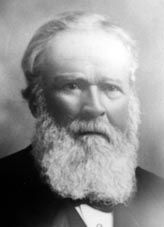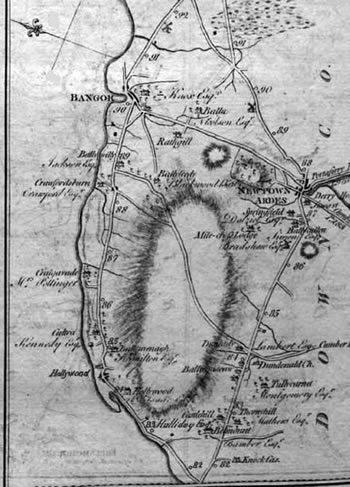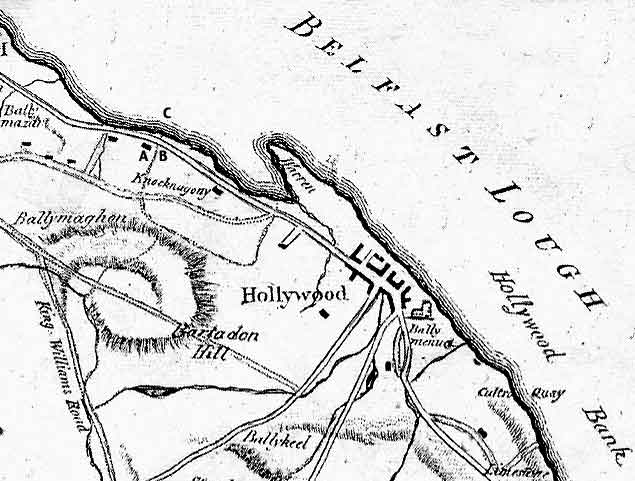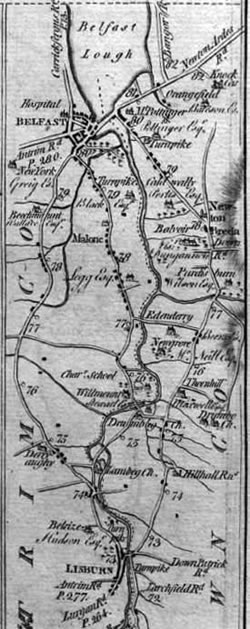The STRONGs of Ulster, Ireland, Chapter 1
 Robert STRONG b. 1830
Robert STRONG b. 1830Courtesy: B&I Strong
The "STRONG Family" section of this site is divided into 13 chapters and 9 appendices. Please read in sequence by following the links at the bottom of each page or use the "Quick Nav" at top right. If you wish to select individual chapters, please click on the top left link to the "Sitemap" page. Note that the chapters develop the story of our family and the appendices contain supporting data… for example the Descendancy Report in Appendix 1 with BDM records and photos of family members.
Contents of this Website are subject to Copyright © by Philip Strong, & allow fair academic use. See here.
Do you have information, opinion or a question relating to either this site’s contents or its copyright? Please use the e-mail link available at the bottom of each page. I look forward to corresponding with you.
This chapter describes the origins of Robert STRONG (Snr) in the parish of Drumbo. Then we examine his life and times in Knocknagoney in the parish of Holywood, all in Co. Down, Northern Ireland.
Robert's son (Robert Jnr.) is pictured at the left. He was born in 1830, probably in Knocknagoney near Belfast, Northern Ireland and died in 1910 in Drury, near Auckland New Zealand.
The remainder of this site tells the story of Robert STRONG (Jnr.) & his families in Belfast, their emigration and life in New Zealand and NSW Australia. Significant details of Robert (Jnr.)’s children are given, which relate to many photos inserted in the text & also to associated photogalleries.
Thanks to my various cousins who have readily provided information, photos etc. They have been acknowledged by name on the various pages which follow. However, particular thanks to Jill Cargill of New Zealand (d. 8 Jul 2003), who collaborated in the research. The story of the STRONGs would not have been possible without her extensive research and help. We are also grateful to Brian and Irene STRONG for permission to reproduce the above photo, as well as providing many photos and much information about the NZ STRONGs. Please see their special acknowledgement.
Robert STRONG (Snr) of Drumbo & Holywood
- Inside this chapter: |
- Introduction |
- Holywood |
- Drumbo |
Introduction
My family asks why I started this research task? The answer is probably the family bible i) . The bible remained relatively unopened when I inherited my father's books… until I realised its significance. My great grandfather had entered birth and death dates of his family… he had even written down some regular censuses of his family. Add to this some newpaper clippings and even a cross-stitch sampler with my g-grandmother’s name. All this information meant a flying start to our family history! However, one aspect of this bible still gives us some conjecture… there is an inscription on leather which says: "Presented by David SLOANE to David STRONG September 1859". Who was David SLOANE? See Family Bible for some images.
Robert STRONG (Snr) was found by good luck! The death certificate of my great-grandfather Robert STRONG (Jnr) who died in Drury, New Zealand provided his birthplace of Holywood, County Down, Ireland, as well as his parents' names...... Robert STRONG and Agnes SLOANE. Holywood is just out of Belfast. An approximate date of birth of 1830 is arrived at from the age 80 given at the time of his death. This in turn gives the approximate date of his parents' marriage...... say 1820-30. Robert was buried in the Presbyterian cemetery at Drury, making it possible that his parents were Presbyterian ii) .
Some NZ cousins remembered the "old people" saying that the family had come from "Knocknancy" iii) . No town (townland) of this name seemed to exist, however there is a Knocknagoney just next to the townland of Holywood and also within the Parish of Holywood. This mention of "Knocknancy" should be treated with caution, since some in-laws had the origin of Knockmany Co. Tyrone which was corrupted in their recollection to "Knockmancy"… oral history is a tricky area! See here for the in-law recollections.
The Public Record Office of Northern Ireland (PRONI) at Belfast has the registers of the Presbyterian Church at Rosemary St., Belfast on microfilm, and it has a record which satisfies all the above data. 13th May 1825:
"I married Robert STRONG, son of John STRONG, late of Drumbo, Robert lives at Knocknagoney, to Agnes Sloan, daughter of Hamilton Sloan of Knocknagoney. Certified by two elders from Holywood. (signed) Samuel Hanna. We whose names are subjoined were present at the above marriage J M Gaby, Robert Sloan, Jane STRONG." iv)
The luck continued! We now have the father of Robert STRONG (senior) established as John STRONG of Drumbo. Does the phrase "late of Drumbo" mean that John died before the Knocknagoney marriage date of 1825, or did it mean he was he a previous resident of Drumbo?
There is a record of a 1781 Probate for a John STRONG in Ballymaghan v) . This townland is adjacent to Knocknagoney in a SE direction, and is the only townland of this name in Ireland (see the map beneath). Unfortunately for our research, the vast majority of the original wills were destroyed in 1922 with the destruction of the Public Records Office. Also, the date of death seems a little early for our John STRONG of Drumbo. On the other hand would be good to get this 1781 Probate… is it a hopeless search?
Bert STRONGE vi) kindly told me that he had found a record of a Rev. John STRONG of Drumbo with year of probate 1779 in a handwritten book in PRONI. JB Wallace does not mention him in his account of Drumbo church vii). Similarly, he was not mentioned in Indexes to Irish Wills v). Perhaps the Presbyterian Historical Society might have a record of this Rev. John STRONG, not to be confused with the Rev. John STRONG of Ballynahinch who died 10 Aug 1780. JB Wallace mentions another Drumbo Presbyterian minister who was linked to our family. He was Rev.Samuel Hanna i), the celebrant of Robert Strong’s marriage in 1825, who was ordained in Drumbo by the Belfast Presbytery on 4 Aug, 1795 vii). Coincidence?
Nothing concrete has been found about "our" John STRONG of Drumbo, apart from a few earlier STRONG records discussed in the Drumbo section beneath.
Holywood
 Map of Holywood and Knocknagoney
Map of Holywood and Knocknagoney "Road from Dublin to Donaghdee", p6. viii)
The 1825 Robert STRONG (Snr) – Agnes SLOAN marriage gave us the Holywood and Knocknagoney mentions ....see the map on left, for detail of these locations. This gave the impetus for a systematic collection of Holywood Parish data… see also the Appendix Section 5. However, a search of the Knocknagoney Griffith's records for 1861 showed no STRONGs and one record of a SLOAN(E)… named Robert SLOANE. Perhaps this was our marriage witness Robert SLOAN? This Griffith's SLOANE occupied the gate lodge in the property above the Clifton House (in Knocknagoney). The 1861 Griffith’s records variously refer to Clifton Manor, Clifton Ville, Clifden. Clifton provides a good point of reference to locate Robert SLOANE’s gate lodge ix). Samuel Lewis x) gives Dr Halliday as the owner of "Clifton" in a list of the "gentlemen's seats" in Holywood. In the left hand map, Halliday Esq "gentleman's seat" is shown at the western base of the steeply rising plateau (180m) next to the 83 mile marker from Dublin (3 miles from Belfast). Holywood is a little further along the road from Belfast past the 84 mile marker. Please note the orientation given in the top corner of this early map. Note, in modern times, the shore of the Lough in this area has been since extended about a mile westward for the Belfast City Airport.
Lieutenant G.F.W. Bordes said in 1834 that: "The Parish of Holywood is the most north-western parish of the barony of Lower Castlereagh, on the shore of the Belfast Lough. Its mean length is 5 miles and mean breadth is 2 miles. It contains 8,067 acres. There are no lakes or rivers and the streams are generally dry in summer. There are no natural woods.... the shore of the Belfast Lough is much ornamented with young plantations." xi)
See the following 1819 map of portion of Holywood Parish which contains the townland of Knocknagoney.
 Holywood Parish & Knocknagoney. From the 1819 Parochial Survey of Ireland.
xii)
Holywood Parish & Knocknagoney. From the 1819 Parochial Survey of Ireland.
xii)Notations (A), (B) & (C) refer to structures recorded in Griffiths 1861 documents.
In the map above, (A) gives the location of Clifton House ix), xii), xiii), Robert SLOANE's gate lodge xiii), ix) is shown by (B) and the locality of a structure (causeway?) xiii) extending into the Belfast Lough, the wooden bridge (over the Tillysburn river) and the nearby Tillysburn railway station (constructed 1851?) xiii), xv) is indicated by (C). Con Auld suggests that the structure over the mud flats of the Lough (a causeway?), could have been used to collect green seaweed for crop fertiliser xiv) . The immediate lessor of Clifton and Robert SLOANE’s gate lodge was John Harrison (Jnr.) in 1861. Clifton was built by the Haliday (Halliday) family in the 18th century, and was still in their possession in the 1850’s xvi). John Harrison (Senr.) bought Clifton in 1854 together with the neighbouring Holywood House and a number of other properties. Clifton House was demolished in 1880, to become the present Knocknagoney House.xv), xvi)
Further details of the boundary of Robert SLOANE's gate lodge lease and the 1861 Griffith’s map is here.
Lt G.F.W. Bordes gave details of Holywood village, which would also apply to Knocknagoney, the neighbouring townland.
"Employment and earnings: The inhabitants derive their chief support from the profit of their houses which are let in the summer season to the sea bathers (from Belfast etc). 6 men and 2 women are employed fishing. Cod is taken in the channel in the winter and plaice, codling in the summer. It is used in part by the inhabitants. When great quantities are taken they are sold in Belfast but this does not frequently occur. Men do not earn much more than 6d per day by their employment in the fishery. They sometimes earn money by rowing to and from vessels in the channels. Tradesmen earn on average from 12s to 15s per week. Trades and occupations in Holywood (village and townland): House carpenters 8, smiths 7, cartwrights 6, wheelwrights 1, masons 8, fishermen 6, fisherwomen 2, butchers 2, bakers 1, publicans 6, grocers 16, haberdashers 4, shoemakers 6, painters 2, tailors 2." xi)
Lt G.F.W. Bordes' general comments on Holywood Parish included:
"Gentlemen's seats: The whole shore of the Belfast Lough in this parish is studded with gentlemen's seats. All these places are ornamented with gardens and plantations. Improvements: The great source of improvement to this parish is its proximity to Belfast, as it is a favourite watering place for the inhabitants of that town and also on account of the constant residence of the gentry. Housing and Fuel: The houses of the peasantry are generally neat and built of stone almost invariably and slated. They have all glass windows and present an appearance of comfort and cleanliness. There is no turf in the parish and the fuel is principally coal, which they obtain from Belfast. Handspinning and Weaving: there is not much hand spinning done in the parish. The greater part of what is done is for home use..... there may be 50 weavers in the parish but not more. Size and Rent of Holdings: The size of the holdings varies from 2 to 70 acres. The rent varies from £4 to £1 per acre. Crop Rotation and Cultivation: The rotation of crops is potatoes, wheat, oats, barley with clover and rye grass. The cattle generally used are the Devonshire and Ayrshire breed." xi)
Drumbo
 Map of County Down: Drumbo and surrounds. x)
Map of County Down: Drumbo and surrounds. x)The 1825 Robert STRONG (Snr)—Agnes SLOAN marriage gives us the Drumbo mention for Robert's father, John of Drumbo. Please refer to the Lewis map x) on the right in the following discussion of locations of STRONG families in and around Drumbo. Note particularly Hol(l)ywood, the Belfast Lough and Belfast at top right of the map, then Drumbo and Drumbeg are at the centre of the map. Dromore (and Tullyglush) is at the bottom western edge of the map and Magheradrool and Ballynahinch on the southern edge. Note how the River Lagan is the NW border between Co. Down and Co. Antrim and also the coloured borders marked between the Baronies of Lower Castlereagh, Upper Castlereagh and Lower Iveagh. Allowing for late marriages of Irish men, the 1825 marriage of my g-g grandfather Robert STRONG (Snr). gives him an estimated date of birth (DOB) about 1800. Using the same logic, Robert's father John STRONG, mentioned in the same marriage register details, has an estimated DOB of about 1775 in Drumbo, since John was described as "late of Drumbo". Thus it is possible that his son Robert was also born in Drumbo.
The earlier and more detailed map shown below is from Taylor and Skinner viii). This shows the Belfast Lough at top centre (Holywood and Knocknagoney are on the Lough's SE shore, about 3 miles from Belfast). Follow the road from this area travelling in a SE direction to Newton Breda, then travel south down to Drumbo Ch. (Church), which is marked 2/3 of the way down the eastern side of the map. Does "late of Drumbo" mean that John lived in the Parish of Drumbo at some stage and he did not die there? Did John live in the Parish of Drumbo or the Townland of Drumbo? If it the word parish was intended, then all of the townlands of Drumbo are possibilities. John, with a DOB of 1775, could have been a property lessee in 1800.
 Drumbo: "Road to Donaghdee", p5 viii)
Drumbo: "Road to Donaghdee", p5 viii)This could be too early for him to be mentioned in the Griffith's Valuation, and perhaps we should look to other records such as The Castlereagh Estate Rental Book xvii). There are a few STRONGs mentioned in this Rental Book for the Drumbo Townland of Crossan around 1800. Bill Cardwell xviii) and Bert STRONGE vi) have kindly looked up this rental book and told me that these STRONGs from Crossan are Margaret, William, Michael, Richard, Nathan and most significantly... John STRONG! However, details of the John STRONG lease are unavailable. Can anyone suggest a way around the "brick wall" to find my John STRONG?
There may have been good economic reasons for John STRONG to leave Drumbo Parish. In 1833 Lieutenant G.F.W. Bordes describes the Parish as follows: "The soil is not good" which was reflected in the agriculture "cultivation is in corn, grass and potatoes. There is very little grazing. The produce... chiefly consists of poultry, butter and eggs".... " linen is the only manufacture and that not to any extent". In spite of the poor agricultural and manufacturing base. Bordes reports that the "parish is thickly peopled and the houses are neat and of stone as quarries are abundant". What if John STRONG lived in Crossan? Bordes described this townland with "20 landholders" and (the quality of the land) "middling". xi)
A census associated with the 1833 survey gives more detail: "Crossan, 55 houses, 31 inhabited, 4 uninhabited, 31 families in occupation, 23 families employed in agriculture, 5 in trade and manufacture, 154 total persons." The occupations were listed as: "3 farmers employing labour, 17 labouring farmers, 3 agricultural labourers, 8 in manufacture, 1 in retail trade and handicraft, 1 professional, 4 male servants above 20, 3 under 20, 6 female servants." xi) Perhaps there may have still been STRONGs amongst these 154 people, noting that in 1825 (only 8 years before this Ordnance Survey) John was described as "late of Drumbo".
Where might John STRONG go when he (and his family?) left Drumbo? John's son Robert lived in Knocknagoney in the Parish of Holywood in 1825. Perhaps John went to Holywood as well? Our STRONG family's choice could have been employment related, or perhaps a place socially similar to Drumbo. In those days, religion was the social and employment determinant and it is assumed that the STRONG family was Presbyterian, since son Robert married Agnes Sloan of Knocknagoney in the Rosemary St. Belfast Presbyterian Church. Bordes reported that in the Drumbo parish "religion is chiefly Protestant".... and there is "a large (Presbyterian) meeting house in the village of Drumbo" xi). A separate Ordnance Survey memoir at that time described this church as orthodox Presbyterian with a congregation of 800 from 400 families xi). The relative strength of the religious denominations in the various parishes was tabulated in the "First Report of the Commission of Public Instruction" in 1834 xxi). It showed that Holywood and Drumbo were quite similar from this aspect.
| Parish | Total | Roman Catholic | Church of Ireland | Presbyterian |
|---|---|---|---|---|
| Drumbo | 8,021 | 3% | 17% | 80% |
| Holywood | 4,795 | 11% | 13% | 76% |
At this stage, Drumbo research is just a work in progress, collecting mentions of STRONG(E)s in the area. Kathy Kenna xix) contributed the 1884 record of the marriage of her ancestor Robert John STRONGE. This marriage occurred in the neighbouring parish of Drumbeg, townland Dunmurry, Co. Antrim. Drumbeg is bounded on the north, south and west in part by the Parish of Drumbo. See the Taylor & Skinner map above, where Drumbeg Church is marked just west of Drumbo Church. Same names as my Drumbo ancestors, same area! Kathy reports that "Robert John's father lived in Tullyglush, parish of Dromore, Co Down, and Robert John emigrated to Pittsburgh, PA, USA in 1913".
Drumbeg was both Co. Antrim and Co. Down! Drumbeg extends west into Co Antrim about 1.75 miles and east into Co Down about 1.5 miles. It would appear that in the early 1800's there was much movement between Drumbo and Drumbeg. In 1833 the Ordnance Survey reports that the people of Drumbeg obtained their turf from the bogs of Drumbo x).
In the 1803 Agricultural Census xxii), one of the Drumbeg parish townlands was incorporated with the Drumbo parish townlands. Lewis then describes in his Topographical Dictionary that "a portion of the parish of Drumboe having been lately (around 1837) added to it (Drumbeg) under the Church Temporalities' Act, it now comprises 6868 acres."x)
Note that Dromore and Tullyglush in the south THEN Lisburn, Drumbo and Drumbeg THEN Holywood and Belfast were part of a highway / trade route to the north. Consequently we would expect that our STRONG(E) ancestors moved between these areas. In Kathy's instance of Robert John STRONGE, he may have gone to Drumbo / Drumbeg Parishes to marry in his ancestral home, since the Tullyglush STRONGEs and the Drumbo / Drumbeg STRONGs were related? To complicate things further, perhaps there was much confusion following the Scot-Irish pronunciation of Drumbeg? It could variously sound like Drumby/ Drumbeg / Drumbo? Perhaps my ancestors also came from Drumbeg?
Another conjectured STRONG linkage is to the nearby Rev. John STRONG of Ballynahinch. His gravestone is in Magheradrool graveyard, on a hill about a mile southwest of Ballynahinch in the townland and parish of Magheradrool. The transcription reads:
"Horizontal stone in the Armstrong enclosure buried in earth and rubbish. Here lyeth the body of David Whyte of Ballymaglave who departed this life 14 Apr 1742 aged 58 years. Also his wife Anne Whyte who died 06 Apr 1762 aged 74 years. Here lies also interred the body of the Revd. John STRONG who died 10 Aug 1780 in the 60th year of his age and 36th of his ministry in the Presbyterian Congregation of Ballynahinch. Also of his wife Anne STRONG alias Whyte who died 10 Aug 1810 aged 86 years. And of two of their children, David and Grace, who both died in infancy. Here also are deposited the remains of John Armstrong, Esq., late of Ballynahinch, who departed this life on 23 Apr 1837 aged 84 years. And of his wife Margaret STRONG, daughter of the Revd. John STRONG, who died on 19 May 1836 aged 86 years." xx)
Perhaps our John STRONG was a son / g-son of Rev. John STRONG, or at least was named after him.
Sources:
i) STRONG family Bible: kept by Philip Strong.
ii) Death of Robert STRONG . Reg# 1910/4538. Registrar of BDM, NZ.
iii) Pers. comm. Brian Strong, New Zealand.
iv) Marriage of Robert Strong & Agnes Sloan. Latter-Day Saints International Genealogical Index (IGI). Batch number: M700181. Film#0883747, item# 18, 1810-1846.
v) Thrift, G. (ed.) Indexes to Irish Wills: Dromore Wills, 1678-1858. Phillimore & Co. London; 1918; 4: 145.
vi) Pers.comm. Bert Stronge, North Ireland.
vii) Wallace, JB. Drumbo Presbyterian Church 1655-1956. (Online).
viii) Taylor & Skinner. Road Maps of Ireland. Dublin; 1783; 5 (Drumbo), 6 (Holywood).
ix) Griffith R. Union of Belfast (part of); Valuation of the several tenements outside the municipal boundary of Belfast, and situate in the County of Down. 1861; 14.
x) Samuel Lewis. Topographical dictionary of Ireland. S. Lewis; London; 1837; text… 1 : 511 (Drumboe), text… 2 : 6 (Holywood), map… Co. Down.
xi) Day, A, Williams P, eds. Ordnance Survey Memoirs of Ireland Volume 7: Parishes of County Down II 1832-4, 1837, North Down & The Ards. 1991; 7: 73-83.
xii) Mason, William Shaw. Parochial Survey of Ireland: Map accompanying the Holywood section. 1819.
xiii) Griffith’s Valuation: Map of Knocknagoney. PRONI VAL/2A/3/4. 1861.
xiv) Pers. comm. Con Auld, North Ireland, Jul 2008.
xv) Auld C. Holywood Co. Down: Then & now. Self-published, Holywood; 2002; 47, 73, 87.
xvi) Auld C. Forgotten houses of Holywood Co. Down. Self-published, Holywood; 2003; 57 - 60.
xvii) The Castlereagh Estate Rental Book for 1801 [PRONI Ref# D/671/R4/1].
xviii) Pers. comm. William Cardwell, North Ireland.
xix) Pers. comm. Kath Kenna, USA.
xx) Vigors Miss, Mahony PG, eds. Memorials of the dead. University Press Dublin; 1914; 7:343.
xxi) First Report of the Commission of Public Instruction. PRONI [MIC/5A/6-9B].
xxii) 1803 agricultural census for Co. Down. PRONI [D/654/A2].
The Story Continues
- Chapter 2 The story of Robert STRONG's son: Robert STRONG (Jnr).